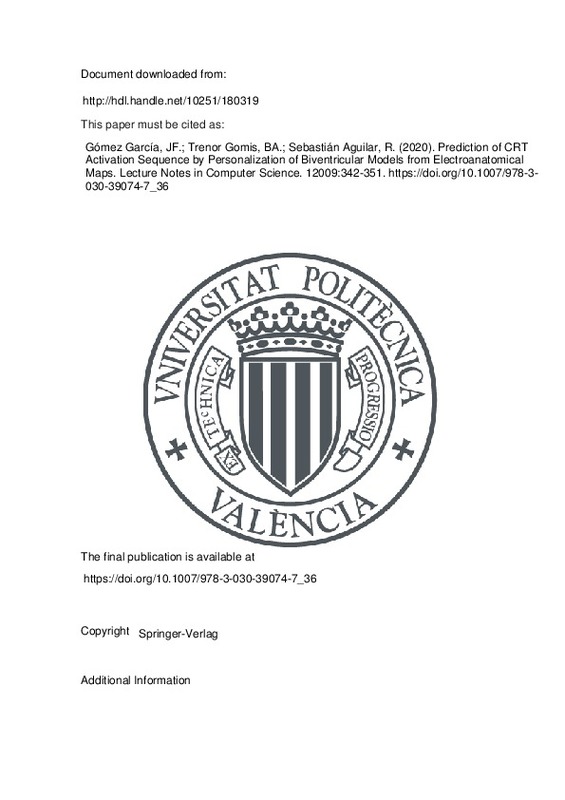JavaScript is disabled for your browser. Some features of this site may not work without it.
Buscar en RiuNet
Listar
Mi cuenta
Estadísticas
Ayuda RiuNet
Admin. UPV
Prediction of CRT Activation Sequence by Personalization of Biventricular Models from Electroanatomical Maps
Mostrar el registro sencillo del ítem
Ficheros en el ítem
| dc.contributor.author | Gómez García, Juan Francisco
|
es_ES |
| dc.contributor.author | Trenor Gomis, Beatriz Ana
|
es_ES |
| dc.contributor.author | Sebastián Aguilar, Rafael
|
es_ES |
| dc.date.accessioned | 2022-01-28T07:40:52Z | |
| dc.date.available | 2022-01-28T07:40:52Z | |
| dc.date.issued | 2020-01-23 | es_ES |
| dc.identifier.issn | 0302-9743 | es_ES |
| dc.identifier.uri | http://hdl.handle.net/10251/180319 | |
| dc.description.abstract | [EN] Optimization of lead placement and interventricular delay settings in patients under cardiac resynchronization therapy is a complex task that might benefit from prior information based on models. Biophysical models can be used to predict the sequence of electrical heart activation in a patient given a set of parameters which should be personalized to the patient. In this paper, we use electroanatomical maps to personalize the endocardial activation of the right ventricle, and the different tissue conductivities in a pig model with left bundle branch block, to reproduce personalized biventricular activations. Following, we tested the personalized heart model by virtually simulating cardiac resynchronization therapy | es_ES |
| dc.description.sponsorship | This work was supported by the "Plan Estatal de Investigacion Cientifica y Tecnica y de Innovacion 2013-2016" from the Ministerio de Economia, Industria y Competitividad of Spain and Fondo Europeo de Desarrollo Regional (FEDER) DPI2016-75799-R (AEI/FEDER, UE), and by the Direccion General de Politica Cientifica de la Generalitat Valenciana (PROMETEU 2016/088) | es_ES |
| dc.language | Inglés | es_ES |
| dc.publisher | Springer-Verlag | es_ES |
| dc.relation.ispartof | Lecture Notes in Computer Science | es_ES |
| dc.rights | Reserva de todos los derechos | es_ES |
| dc.subject | Cardiac resynchronization therapy | es_ES |
| dc.subject | Tissue properties personalization | es_ES |
| dc.subject | Biophysical modeling | es_ES |
| dc.subject.classification | TECNOLOGIA ELECTRONICA | es_ES |
| dc.title | Prediction of CRT Activation Sequence by Personalization of Biventricular Models from Electroanatomical Maps | es_ES |
| dc.type | Artículo | es_ES |
| dc.identifier.doi | 10.1007/978-3-030-39074-7_36 | es_ES |
| dc.relation.projectID | info:eu-repo/grantAgreement/GENERALITAT VALENCIANA//PROMETEO%2F2016%2F088//MODELOS COMPUTACIONALES PERSONALIZADOS MULTI-ESCALA PARA LA OPTIMIZACION DEL DIAGNOSTICO Y TRATAMIENTO DE ARRITMIAS CARDIACAS (PERSONALISED DIGITAL HEART)/ | es_ES |
| dc.relation.projectID | info:eu-repo/grantAgreement/AEI//DPI2016-75799-R//TECNOLOGIAS COMPUTACIONALES PARA LA OPTIMIZACION DE TERAPIAS PERSONALIZADAS DE PATOLOGIAS AURICULARES Y VENTRICULARES/ | es_ES |
| dc.rights.accessRights | Abierto | es_ES |
| dc.contributor.affiliation | Universitat Politècnica de València. Departamento de Ingeniería Electrónica - Departament d'Enginyeria Electrònica | es_ES |
| dc.contributor.affiliation | Universitat Politècnica de València. Instituto Interuniversitario de Investigación en Bioingeniería y Tecnología Orientada al Ser Humano - Institut Interuniversitari d'Investigació en Bioenginyeria i Tecnologia Orientada a l'Ésser Humà | es_ES |
| dc.description.bibliographicCitation | Gómez García, JF.; Trenor Gomis, BA.; Sebastián Aguilar, R. (2020). Prediction of CRT Activation Sequence by Personalization of Biventricular Models from Electroanatomical Maps. Lecture Notes in Computer Science. 12009:342-351. https://doi.org/10.1007/978-3-030-39074-7_36 | es_ES |
| dc.description.accrualMethod | S | es_ES |
| dc.relation.publisherversion | https://doi.org/10.1007/978-3-030-39074-7_36 | es_ES |
| dc.description.upvformatpinicio | 342 | es_ES |
| dc.description.upvformatpfin | 351 | es_ES |
| dc.type.version | info:eu-repo/semantics/publishedVersion | es_ES |
| dc.description.volume | 12009 | es_ES |
| dc.relation.pasarela | S\443428 | es_ES |
| dc.contributor.funder | GENERALITAT VALENCIANA | es_ES |
| dc.contributor.funder | AGENCIA ESTATAL DE INVESTIGACION | es_ES |
| dc.contributor.funder | European Regional Development Fund | es_ES |
| dc.description.references | Auricchio, A., et al.: Characterization of left ventricular activation in patients with heart failure and left bundle-branch block. Circulation 109(9), 1133–9 (2004). https://doi.org/10.1161/01.CIR.0000118502.91105.F6 | es_ES |
| dc.description.references | Bristow, M.R., et al.: Comparison of medical therapy, pacing, and defibrillation in heart failure (COMPANION) investigators: cardiac-resynchronization therapy with or without an implantable defibrillator in advanced chronic heart failure. N. Engl. J. Med. 350(21), 2140–50 (2004). https://doi.org/10.1056/NEJMoa032423 | es_ES |
| dc.description.references | Carpio, E.F., et al.: Optimization of lead placement in the right ventricle during cardiac resynchronization therapy. A simulation study. Front. Physiol. 10, 74 (2019). https://doi.org/10.3389/fphys.2019.00074 | es_ES |
| dc.description.references | Dawoud, F., et al.: Non-invasive electromechanical activation imaging as a tool to study left ventricular dyssynchronous patients: implication for crt therapy. J. Electrocardiol. 49(3), 375–82 (2016). https://doi.org/10.1016/j.jelectrocard.2016.02.011 | es_ES |
| dc.description.references | Doste, R., et al.: A rule-based method to model myocardial fiber orientation in cardiac biventricular geometries with outflow tracts. Int. J. Numer. Method Biomed. Eng. 35(4), e3185 (2019). https://doi.org/10.1002/cnm.3185 | es_ES |
| dc.description.references | Garcia-Bustos, V., Sebastian, R., Izquierdo, M., Molina, P., Chorro, F.J., Ruiz-Sauri, A.: A quantitative structural and morphometric analysis of the purkinje network and the purkinje-myocardial junctions in pig hearts. J. Anat. 230(5), 664–678 (2017). https://doi.org/10.1111/joa.12594 | es_ES |
| dc.description.references | Lopez-Perez, A., Sebastian, R., Ferrero, J.M.: Three-dimensional cardiac computational modelling: methods, features and applications. Biomed. Eng. Online 14, 35 (2015). https://doi.org/10.1186/s12938-015-0033-5 | es_ES |
| dc.description.references | Moss, A.J., et al.: MADIT-CRT trial investigators:cardiac-resynchronization therapy for the prevention of heart-failure events. N. Engl. J. Med. 361(14), 1329–38 (2009). https://doi.org/10.1056/NEJMoa0906431 | es_ES |
| dc.description.references | Soto Iglesias, D., et al.: Quantitative analysis of electro-anatomical maps: application to an experimental model of left bundle branch block/cardiac resynchronization therapy. IEEE J. Transl. Eng. Health Med. 5, 1900215 (2017). https://doi.org/10.1109/JTEHM.2016.2634006 | es_ES |
| dc.description.references | Tobon-Gomez, C., et al.: Understanding the mechanisms amenable to crt response: from pre-operative multimodal image data to patient-specific computational models. Med. Biol. Eng. Comput. 51(11), 1235–50 (2013). https://doi.org/10.1007/s11517-013-1044-7 | es_ES |
| dc.subject.ods | 03.- Garantizar una vida saludable y promover el bienestar para todos y todas en todas las edades | es_ES |







![[Cerrado]](/themes/UPV/images/candado.png)

